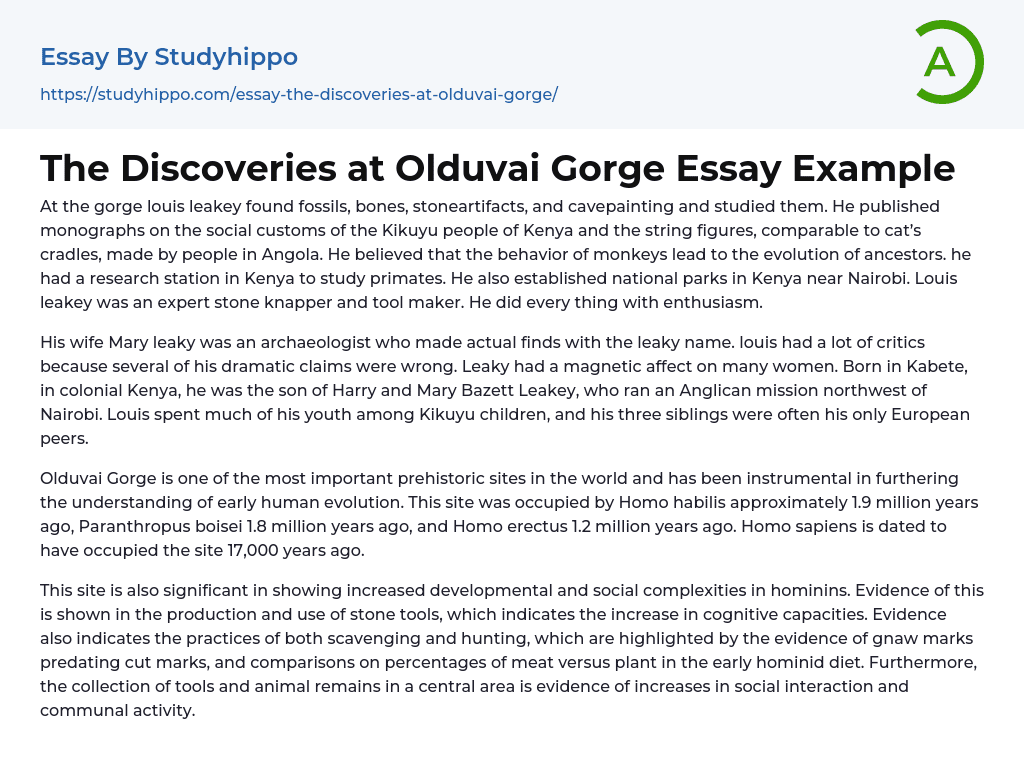Louis Leakey conducted extensive research at the gorge, where he discovered fossils, bones, stone artifacts, and cave paintings. In addition to his archaeological findings, he published monographs on the social customs of the Kikuyu people of Kenya and the string figures created by the people of Angola. Leakey also had a research station in Kenya dedicated to the study of primates and played a key role in establishing national parks near Nairobi. Notably, he was highly skilled in stone knapping and tool making and approached all his endeavors with great enthusiasm.
His wife Mary Leaky was an archaeologist who made actual finds with the Leaky name. Louis had many critics because several of his dramatic claims were incorrect. Leaky had a magnetic effect on many women. He was born in Kabete, in colonial Kenya, and he was the son of Harry and Ma
...ry Bazett Leakey, who ran an Anglican mission northwest of Nairobi. Louis spent a significant portion of his childhood with Kikuyu children, and his three siblings were often the only Europeans he interacted with.
Olduvai Gorge, a significant prehistoric site, has greatly advanced our understanding of early human evolution. Around 1.9 million years ago, Homo habilis inhabited the area, followed by Paranthropus boisei approximately 1.8 million years ago and Homo erectus about 1.2 million years ago. The presence of Homo sapiens at Olduvai Gorge can be traced back to around 17,000 years ago.
This site demonstrates increased developmental and social complexities in hominins. The production and use of stone tools signify an enhancement in cognitive capacities. Furthermore, evidence shows practices of scavenging and hunting, as highlighted by the
presence of gnaw marks preceding cut marks and comparisons on meat and plant percentages in the early hominid diet. Additionally, the central collection of tools and animal remains indicates increases in social interaction and communal activity.
- Population essays
- Cultural Assimilation essays
- Demography essays
- Ethnographic essays
- Population Growth essays
- Object-Oriented Programming essays
- Java essays
- Electronics essays
- Computer Science essays
- Consumer Electronics essays
- Enterprise Technology essays
- Hardware essays
- Robot essays
- engineering essays
- people search essays
- Modern Technology essays
- Impact of Technology essays
- Cloud Computing essays
- Operating Systems essays
- Information Technology essays
- Data Analysis essays
- Information Age essays
- Smartphone essays
- Cell Phones essays
- Camera essays
- Computer essays
- Ipod essays
- Mobile Phones essays
- 3g essays
- Bluetooth essays
- Cell Phones in School essays
- Computer File essays
- Desktop Computer essays
- Servers essays
- Data collection essays
- Graphic Design essays
- Data Mining essays
- Cryptography essays
- Internet essays
- Network Security essays
- Android essays
- Computer Security essays
- World Wide Web essays
- Website essays
- Computer Network essays
- Application Software essays
- Computer Programming essays
- Computer Software essays
- Benchmark essays
- Information Systems essays




